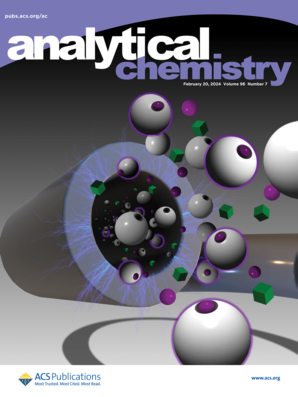SNAr-Based Labeling of Proteins with Trityl Radicals Enables High-Precision, High-Sensitivity, and Long-Range Distance Measurement
IF 6.7
1区 化学
Q1 CHEMISTRY, ANALYTICAL
引用次数: 0
Abstract
Distance measurement using pulsed dipolar electron paramagnetic resonance spectroscopy (PD-EPR) coupled with site-directed spin labeling is a powerful approach to study the structure and dynamics of biomolecules in nearly native environments. However, the accuracy and sensitivity of the distance measurement in cellular systems is often limited by long, flexible, and/or reduction-sensitive linker of spin labels and their low biostability. Herein, we report the first class of aryl-linked trityl spin labels in which pyrimidine and pyridine methylsulfones (FPS1–2) act as protein tagging groups and are directly conjugated to the trityl moiety. FPS1 underwent a specific nucleophilic aromatic substitution (SNAr) reaction with cysteine (Cys) as its free form or in glutathione (GSH) and proteins to produce stable C–S conjugation. The resulting conjugates experienced negligible hydrolysis after a long-term measurement and exhibited high biostability to the commonly used reducing agents and also in cell lysates, which is in contrast to the conjugates of the maleimide spin label, CT02MA. PD-EPR studies on the FPS1-labeled immunoglobulin G-binding protein (GB1) and second-mitochondrion-derived activator of caspases (Smac) demonstrated that FPS1 enables highly sensitive and long-range distance measurement in the proteins. Importantly, due to its short and rigid aryl linker, the use of FPS1 provides significantly narrower distance distributions than those from the maleimide spin labels CT02MA and OXMA. Moreover, using FPS1, the longest distance measurement (∼6.01 nm) so far in all of the trityl-labeled protein samples has also been achieved in the FPS1-labeled Smac. Overall, this work demonstrates that the SNAr-based aryl groups can be ideally united into the skeleton of trityl radicals, and the resulting spin labels enable sensitive, precise, and ultralong distance measurements in proteins under diverse conditions.

基于snar标记的蛋白质与三基自由基实现高精度,高灵敏度和远程距离测量
脉冲偶极电子顺磁共振波谱(PD-EPR)距离测量结合定点自旋标记是研究生物分子结构和动力学的一种有效方法。然而,细胞系统中距离测量的准确性和灵敏度往往受到自旋标签的长,灵活和/或还原敏感连接物及其低生物稳定性的限制。本文报道了一类以嘧啶和吡啶甲基砜(FPS1-2)作为蛋白质标记基团并直接偶联到三烷基部分的芳基连接的三烷基自旋标签。FPS1与游离形式的半胱氨酸(Cys)或谷胱甘肽(GSH)和蛋白质发生特异性亲核芳香取代(SNAr)反应,产生稳定的C-S偶联。经过长期测量,所得的偶联物的水解可以忽略不计,并且对常用的还原剂和细胞裂解物表现出很高的生物稳定性,这与马来酰亚胺自旋标签CT02MA的偶联物形成对比。对FPS1标记的免疫球蛋白g结合蛋白(GB1)和第二线粒体来源的半胱天冬酶激活因子(Smac)的PD-EPR研究表明,FPS1可以对蛋白质进行高度敏感和远距离的距离测量。重要的是,由于其短而刚性的芳基连接,使用FPS1比使用马来酰亚胺自旋标签CT02MA和OXMA提供了明显更窄的距离分布。此外,使用FPS1,在FPS1标记的Smac中也实现了迄今为止在所有三烷基标记的蛋白质样品中最长的距离测量(~ 6.01 nm)。总的来说,这项工作表明,基于snar的芳基可以理想地结合到三烷基自由基的骨架中,并且由此产生的自旋标签可以在不同条件下对蛋白质进行敏感,精确和超长的距离测量。
本文章由计算机程序翻译,如有差异,请以英文原文为准。
求助全文
约1分钟内获得全文
求助全文
来源期刊

Analytical Chemistry
化学-分析化学
CiteScore
12.10
自引率
12.20%
发文量
1949
审稿时长
1.4 months
期刊介绍:
Analytical Chemistry, a peer-reviewed research journal, focuses on disseminating new and original knowledge across all branches of analytical chemistry. Fundamental articles may explore general principles of chemical measurement science and need not directly address existing or potential analytical methodology. They can be entirely theoretical or report experimental results. Contributions may cover various phases of analytical operations, including sampling, bioanalysis, electrochemistry, mass spectrometry, microscale and nanoscale systems, environmental analysis, separations, spectroscopy, chemical reactions and selectivity, instrumentation, imaging, surface analysis, and data processing. Papers discussing known analytical methods should present a significant, original application of the method, a notable improvement, or results on an important analyte.
 求助内容:
求助内容: 应助结果提醒方式:
应助结果提醒方式:


